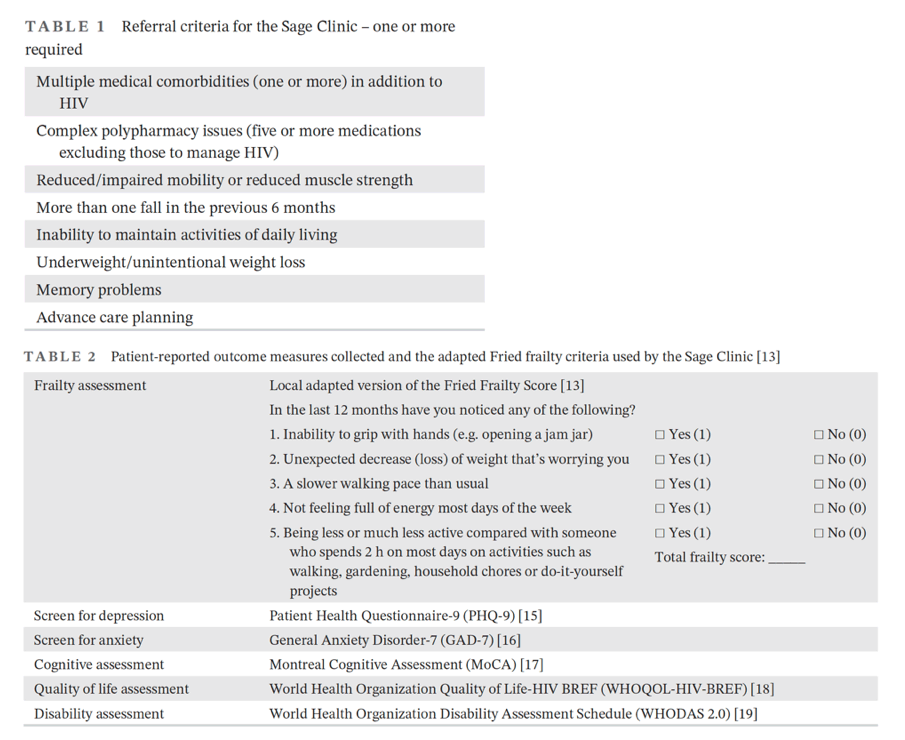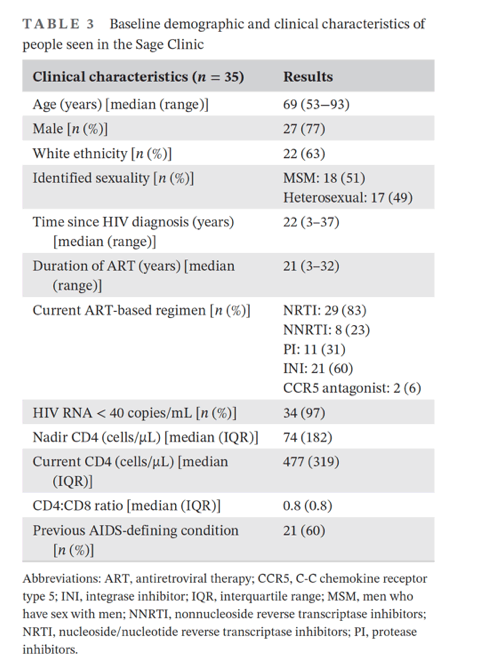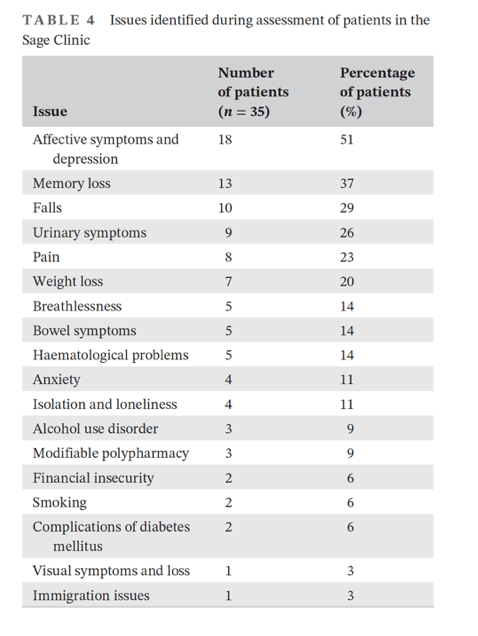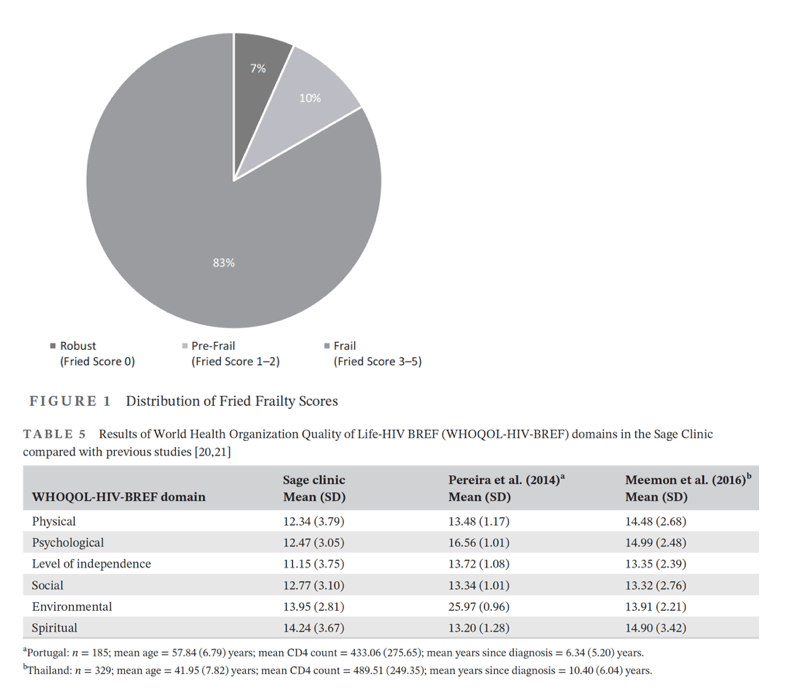| |
What problems associated with ageing are seen in a
specialist service for older people living with HIV? at the SAGE Clinic in London
|
| |
| |
Download the PDF here
Conclusions
Whilst older people living with HIV are a heterogeneous group frailty is common and appears to present earlier. HIV services either need to adapt to meet these additional needs or must support users in transitioning to existing services. We feel that our multidisciplinary model is successful in identifying problems associated with ageing in people living with HIV and could be successfully replicated elsewhere.
Practitioner Points
1. Frailty in common and can present earlier in people living with HIV.
2. Prevalent features of ageing in people living with HIV includes depression, cognitive impairment, polypharmacy and falls.
3. A multidisciplinary model is successful in identifying and managing problems associated with ageing in older people living with HIV.
Models of care for older people living with HIV vary worldwide. Management of ageing-related problems and frailty is becoming more central to the design and delivery of HIV services, with EACS emphasizing the importance of frailty screening and BHIVA promoting the incorporation of geriatricians into the care of complex older people living with HIV. Our results also highlight the wide nature of ageing with HIV, with 18 different issues identified. Twenty-six (74%) patients completed the WHODAS 2.0 assessment with a median score of 36 (IQR 32), approximately correlating to the 90% population percentile demonstrating a high level of disability within the cohort. Depression was common, with 51% of patients subjectively reporting affective symptoms supported by the median PHQ-9 score being 11, confirming a similar rate objectively. A high prevalence of depression in older people living with HIV has been reported previously, with a US study reporting a rate of 52% of participants (n = 1000) feeling depressed within the last year. Cognitive impairment in older people living with HIV is commonly reported when the HIV-associated neurocognitive disorders (HAND) criteria are applied. This shows that while our sample is small, our results corroborate previous studies, emphasizing the importance of enquiring about memory problems with services having clear local protocols for either in-house objective assessment or onward referral. Patients within our cohort with depression, anxiety or suspected cognitive impairment were managed by referrals to in-house peer support, psychology or liaison psychiatry services with a high rate of uptake by attendees. However, ageing alone is unlikely to be responsible for this, so these results support the recommendations of the British HIV Association (BHIVA) and European AIDS Clinical Society (EACS) to screen all patients, as our service does, for affective symptoms at least annually [32, 33].
In this analysis of PLW who were an average 69 years old (53-93) who were referred to the SAGE Clinic at Royal Free Hospital HIV Clinic in London -
• 90% population percentile demonstrating a high level of disability
• 18 different issues identified.
• Depression was common, with 51% of patients
• (37%) of patients in our sample reported memory problems, with 63% of those who completed a MoCA
• majority (83%) being identified as frail, 10% as pre-frail and only 7% assessed as being robust
• Depression was the most common problem reported by over half of the sample (51%).
• Other common issues included memory problems (37%), falls (29%) and unexplained weight loss (20%). Polypharmacy (classified as five or more medications excluding ART) was present in 24 cases (69%) but only modifiable in three (9%).
• 23% reported weight loss.
• 23% reported pain.
• Socioeconomic factors such as poverty rates have been show to impact rates of frailty directly
• The WHOQOL-HIV-BREF was completed by 30 (86%) attendees, demonstrating worse QOL across the physical, psychological, level of independence and social domains (Table 5) when compared with results from previously described cohorts [18, 20, 21]. Twenty-six (74%) patients completed the WHODAS 2.0 assessment with a median score of 36 (IQR 32), approximately correlating to the 90% population percentile demonstrating a high level of disability within the cohort
CONCLUSIONS
Although older people living with HIV are a heterogeneous group, frailty is common and appears to present earlier. Our data demonstrate a high prevalence of affective and cognitive symptoms within this cohort. HIV services either need to adapt to meet these additional needs or must support users in transitioning to existing services. We feel that our multidisciplinary model of incorporating geriatricians, HIV physicians, physiotherapists, occupational therapists, HIV specialist pharmacists and HIV specialist nurses into a single clinic is successful in identifying problems associated with ageing with HIV and, funding permitting, may be successfully replicated elsewhere depending on local clinic size, demographics and need.
Feedback from attendees was predominately positive, with many happy to have had the opportunity to discuss issues not typically explored. Several highlighted the clinic being conducted within the HIV outpatient department as an incentive for them to attend, as they were fearful of mainstream services due to concerns about discrimination.
Management of ageing-related problems and frailty is becoming more central to the design and delivery of HIV services, with EACS emphasizing the importance of frailty screening and BHIVA promoting the incorporation of geriatricians into the care of complex older people living with HIV [32, 33]. Similar models of care, incorporating geriatricians into HIV services to deliver CGA, have been discussed previously, but given our location and population we have achieved almost equivalent numbers of patients through the service in a considerably shorter time, as well as having greater variability in gender, race and sexual orientation, which can impact the presentation of frailty [11].
-----------------------
Conventional ageing research considers older people to be over the age of over 65; however, in HIV research, age > 50 years classes you as older due to the precedent set by the US Centers for Disease Control's original age stratification of HIV/AIDS [2]. Data from 2018 showed that in the UK 39% of those accessing HIV services were over the age of 50, which consisted of people ageing with HIV as well as those who were diagnosed at an older age, and it is expected that by 2030 this will increase to 70%.
Models of care for older people living with HIV vary worldwide. Management of ageing-related problems and frailty is becoming more central to the design and delivery of HIV services, with EACS emphasizing the importance of frailty screening and BHIVA promoting the incorporation of geriatricians into the care of complex older people living with HIV [32, 33]. Similar models of care, incorporating geriatricians into HIV services to deliver CGA, have been discussed previously, but given our location and population we have achieved almost equivalent numbers of patients through the service in a considerably shorter time, as well as having greater variability in gender, race and sexual orientation, which can impact the presentation of frailty [11].
Frailty is associated with increased rates of multi-morbidity, disability, long-term residential care placement, hospitalization and death and can present earlier in those living with HIV.
Currently there is no gold standard model for managing people living with HIV as they age. Several models have been proposed internationally including joint HIV and geriatric medicine clinics such as the 'Silver Clinic' in Brighton, UK, and the 'Golden Compass Programme' in San Francisco, US [11, 12]. As many HIV physicians may be unfamiliar with frailty, while geriatricians lack experience of HIV, joint services such as these may allow for more holistic care.
The Ian Charleson Day Centre (ICDC) was established at the Royal Free Hospital in 1990 as the first open-access clinic for people with HIV in the UK and currently coordinates the care of 3200 people, just over half of whom are older than 50. Many service users were presenting with problems related to ageing, so a dedicated monthly multidisciplinary clinic, 'The Sage Clinic' (non-acronymous), was formed with the aim of identifying and managing these problems.
RESULTS
Our results also highlight the wide nature of ageing with HIV, with 18 different issues identified. Depression was common, with 51% of patients subjectively reporting affective symptoms supported by the median PHQ-9 score being 11, confirming a similar rate objectively. A high prevalence of depression in older people living with HIV has been reported previously, with a US study reporting a rate of 52% of participants (n = 1000) feeling depressed within the last year [31]. However, ageing alone is unlikely to be responsible for this, so these results support the recommendations of the British HIV Association (BHIVA) and European AIDS Clinical Society (EACS) to screen all patients, as our service does, for affective symptoms at least annually [32, 33]. Just over a third (37%) of patients in our sample reported memory problems, with 63% of those who completed a MoCA (n = 8) having an abnormal result. Cognitive impairment in older people living with HIV is commonly reported when the HIV-associated neurocognitive disorders (HAND) criteria are applied [34]. This shows that while our sample is small, our results corroborate previous studies, emphasizing the importance of enquiring about memory problems with services having clear local protocols for either in-house objective assessment or onward referral. Patients within our cohort with depression, anxiety or suspected cognitive impairment were managed by referrals to in-house peer support, psychology or liaison psychiatry services with a high rate of uptake by attendees. 29% of the patients reported recurrent falls, which is similar to the findings of a US study (n = 155) where 26% reported falling often.
Twenty-six (74%) patients completed the WHODAS 2.0 assessment with a median score of 36 (IQR 32), approximately correlating to the 90% population percentile demonstrating a high level of disability within the cohort
Depression was the most common problem reported by over half of the sample (51%). Other common issues included memory problems (37%), falls (29%) and unexplained weight loss (20%). Polypharmacy (classified as five or more medications excluding ART) was present in 24 cases (69%) but only modifiable in three (9%).
Problems not directly related to ageing were also identified, such as smoking, alcohol use disorder, financial insecurity and immigration issues, but these are relevant as they can cause physical or psychological morbidity leading to frailty.
Thirty (86%) patients engaged with frailty scoring (Figure 1) with the majority (83%) being identified as frail, 10% as pre-frail and only 7% assessed as being robust (range 0–5).
All patients reported issues related to ageing with HIV regardless of their Fried score, highlighting that lower frailty scores do not always equate to uncomplicated ageing. Frailty was prominent in our sample, with 83% classified as frail and a further 10% as pre-frail. Our sample is small and preselected and it is likely that we were referred those who were considered most symptomatic by their HIV clinicians, thus explaining why the prevalence is so high, although the full spectrum of Fried scores (0–5) was seen. The prevalence in our study is higher than data from an Australian study which reported 28% and results from a service for older people living with HIV in Brighton, UK, which reported a prevalence of 65% [11, 15]. These factors emphasize that the method of defining and identifying frailty impacts the results of prevalence.
The reported low QOL and higher proportion of disability within our sample are similar to results found in previous studies [20, 21, 25, 26]. Socioeconomic factors such as poverty rates have been show to impact rates of frailty directly [27].
People living with HIV are two-thirds more likely to be current tobacco smokers despite smoking having been shown to significantly increase the risk of frailty.
-----------------------------------




|
|
| |
| |
|
|
|